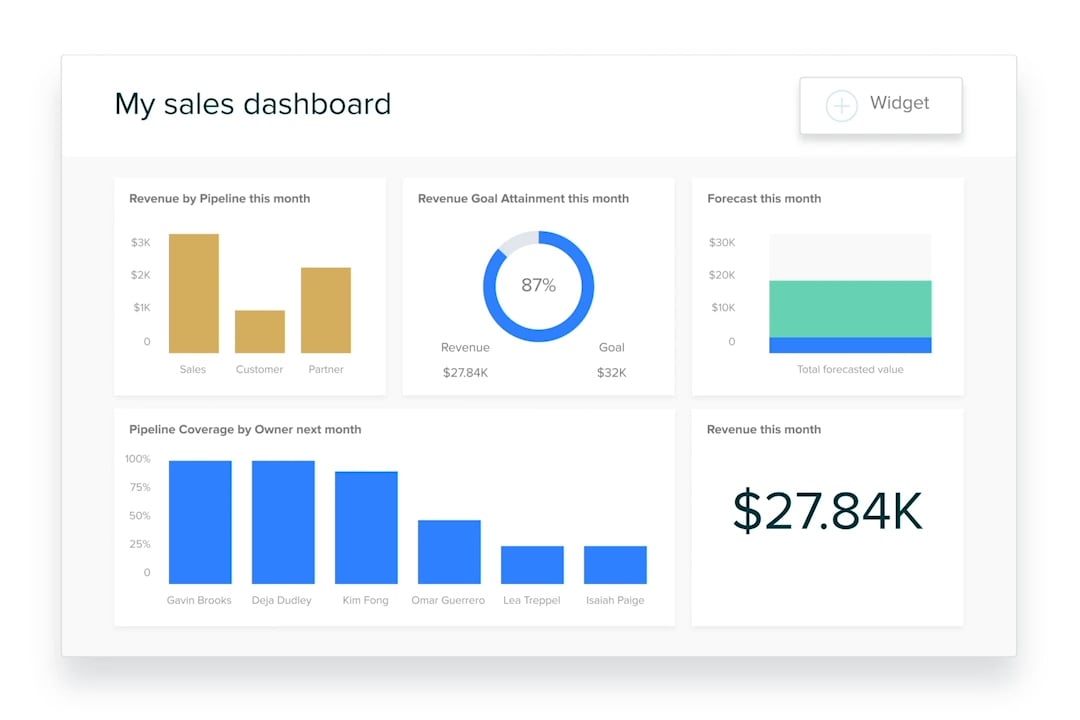CRM analytics
Learn more about your customers and make smart decisions with CRM analytics.
Data analysis with your CRM
최종 업데이트: April 5, 2024
What if you could know what customers are really thinking? Or have an accurate prediction of your company’s revenue for the year? Or get a swift and definitive answer on which of your sales strategies is most effective?
While true business omniscience hasn’t been invented (yet), these hypothetical questions can now be answered—with surprising levels of accuracy—through the power of CRM data analysis.
Analyzing business data collected from your CRM in order to make informed decisions isn’t new. In fact, many of your competitors are already doing so. According to a recent study by Grand View Research, 91 percent of companies with 10 or more employees use a CRM software. Another study found that of that 91 percent, 74 percent agreed that CRM technology gives them better access to data.
With CRM usage only growing, learning how to benefit from CRM analytics is a must. As data analysis stops being a competitive edge and starts becoming the norm, it’s crucial to have your system set up for success.
In this guide, we’ll give you expert insight into:
- What are CRM analytics?
- Benefits of CRM data analysis
- CRM analysis applications
- What to look for in CRM analytics tools
- CRM analysis FAQs
What are CRM analytics?
CRM analytics refer to a CRM’s ability to collect and organize data across your business and analyze it to produce informative reports.
This powerful tool helps businesses gain fuller visibility into their strengths and weaknesses. Using a CRM software, businesses can optimize their sales, marketing, and customer service approaches in order to better reach and satisfy their customer base.
CRMs continuously gather information, and with AI capabilities many programs are even able to make recommendations for next steps based on their actionable data.

Benefits of CRM data analysis
The benefits of CRM data analysis are company-wide: marketing, sales, and customer service departments can all benefit from getting more visibility into their operations. Access to data and reporting also expedites decision-making and leads to an increase of productivity by up to 14.6 percent. That productivity is valuable. In fact, the average ROI on a CRM in 2021 was around $30 for every dollar spent.
Let’s examine the specific benefits of CRM data analysis for each of your departments:
CRM Analytics for Sales
When it comes to building the best CRM sales process steps, data is critical to not only stay competitive in today’s market but drive revenue. CRM analytics for sales teams can track:
- Lead drop-out rates at different sales stages
- Stage duration/Pipeline analysis
- Number, length, and success of sales calls
- Lead and deal source performance
- Sales rep performance: outreach, demos, win rates, etc.
- Loss rates and reasons
Sales analytics tell you exactly what’s working for your sales teams—and what isn’t. By constantly refining your sales process using data-driven strategies, your sales team will be able to move more leads seamlessly through their pipelines, leading to higher conversion rates and increased revenue.
Also, accurate forecasting analytical tools help sales organizations predict future revenue. This lets businesses budget, plan, and invest with confidence—because their choices are based on fact, and not gut instinct.
CRM Analytics for Customer Service
CRM analytics tools allow you to closely monitor your customer service practices. Then, by identifying the practices that produce the most complete customer satisfaction, your customer service reps can continue to refine their approaches.
CRM data analysis can also be used to analyze feedback from surveys and to track pain points with your company. This lets you get ahead of issues that may cause a strain on your customer service operations down the road.
The key to getting the most benefit out of your CRM analytics tool is to make sure your customer data is easily accessible—and accurate for everyone. This allows you to scale your business with full visibility into what’s helping growth, and what’s hindering it.
CRM Analytics for Marketing
Using CRM data analysis helps optimize your marketing campaigns and deliver more deeply personalized messaging to your ideal buyers. Just as a start, CRM analytics tools can easily track:
- Marketing email open rates and times
- Link click-through rates
- Social media post interactions
- Watch and rewatch rates and times for marketing campaign videos
- When video viewership dropped off
All this data helps businesses understand which of their advertising messages and strategies are most effective, and which ones can be improved. Then, as they tweak their messaging and strategize new angles, they can monitor the success—or failure—of their efforts in real time.
CRM analysis applications
Because of the wide range of data they are able to collect, CRMs boast a ton of useful features. The most commonly used CRM analytics features are:
- Customer retention: CRMs collect data on every single customer interaction. This can involve gathering customer feedback from surveys, automatically logging interactions across channels, and storing information like demographics and preferences. By better understanding their customers’ behavior and values, they can provide the kind of service that keeps them coming back.
- Customer acquisition: Analytics can track a lead’s interactions with your company, segment databases by persona, and rank leads to prioritize where sales reps focus their attention. All of this helps to build time-efficient pipelines that are designed to guide leads through the sales process as quickly and effortlessly as possible. This feature can also be used by marketing teams to build targeted messaging that attracts the best qualified leads.
- Report generation: CRM reports help make all of your data easy to view. A great CRM channels data into visual charts, graphs, and comparisons that are simple for users to interpret. Some platforms even automatically interpret the data for you, and suggest specific areas for improvement. You can also set up performance dashboards with live updates on moving numbers like revenue and new deals.
- Data management: CRM platforms feature dashboards across teams in the organization, including sales and service, where you can access all the important metrics in one central place. Users can customize which reports they see regularly, and share relevant data internally with team members to prevent information silos.
What to look for in CRM analytics tools
Not all types of CRM systems are created equal, so when you’re in the market for one, you need to know exactly what your company needs and wants. Here are a few CRM questions to ask when determining your business’ CRM requirements.
- What are your company’s goals? Are you looking to shorten your sales cycle? Better understand rep performance? Improve your customer retention numbers? Think of what data may allow you to reach these goals, and look for platforms that offer that kind of reporting. If you’re trying to look at the big picture, make sure your CRM offers full pipeline visibility.
- What are your company’s plans for growth? Are you looking to expand territories? Introduce new products to your line? Offer more services? Make sure you choose a platform that has the capabilities to grow with you and provide all of the features you may need in the future. Always look for scalability. If your CRM can’t grow with your company, it won’t be worth investing in for very long. That’s why you should always look for a CRM with different levels of tech that suit where your company is at a given moment, as well as open APIs and frameworks that give you added flexibility to make your CRM fit your exact needs.
- Where does your business operate from? If your team members are spread out, you’ll want to invest in a cloud CRM. Cloud technology lets you securely access, share, and update information into your CRM platform. Otherwise, if you plan on operating only on-premise, you may not need an online CRM.
Sales software can be expensive, and depending on the size of your business, you may not need every single available feature. It’s important to know exactly how much you’re spending and what tools you’re spending it on. Zendesk offers transparent pricing for a range of CRM packages that include features like advanced analytics, sales engagement tools, automated tasks , integrated communication channels, and more.
CRM analytics FAQs
What is CRM data analysis?
CRM data analysis is a tool that works to process existing data within your CRM system and provide insights for future sales and business decisions. CRM data analysis gathers customer, sales, marketing, and product data and transforms it into easily understood visuals. With these analytics on hand, it’s simple for your company to continuously improve strategies across departments and make better-informed, customer-conscious business decisions in the future.
How do you conduct a CRM analysis?
Most reporting and analysis happens through the CRM dashboard. On the dashboard, you can select different reports you’d like to see by category. For example, if you wanted to look at your calls reports, you can click on the calls dashboard and then input parameters.
In Zendesk, the calls dashboard leads with key metrics:

These metrics are then followed by a series of reports based on the data you need. For instance, if you wanted to look at outgoing calls by week, you would input those parameters and generate a graph like this:

This process works for the majority of data and reporting within your CRM.
What is an example of an analytical CRM?
Zendesk Sell is a great example of a CRM with robust reporting and analytics capabilities. With a full suite of powerful tools, including tools to boost productivity, integrations with Zendesk Support, and data regarding your sales performance and pipeline, Zendesk Sell makes day-to-day prospect and customer interactions simple. And with streamlined analytical tools, it delivers everything you need to accelerate your sales process and close deals. All with less effort on your end.
Zendesk Sell comes with an array of pre-built dashboards based on industry best practices. These cover several key ways sales leaders interact with their prospect and customer data. . You can customize which reports you see, and easily share data internally within the platform. Zendesk’s reporting and analytics illuminate areas for improvement, and shine a light on new opportunities.
Is CRM primarily data management?
Yes. At their most basic, CRMs are primarily designed to manage data. However, the insights gleaned from analysis of that data are invaluable to a competitive business strategy in the modern market.
CRMs also provide a slew of other useful capabilities. With a CRM, you can:
- Automate and facilitate prospect interactions
- Align sales and marketing departments for smoother flow
- Track sales rep activities and alert them when it’s time for the next step
- Generate and qualify leads
- Provide pipeline visibility
- Create a knowledge base for key sales tools such as sales scripts and marketing materials
- Log calls and emails for individual contacts for more complete customer profiles
It’s time to make informed decisions
If you’re ready to start making the most of your data, Zendesk is a powerful full-scale sales CRM platform with a wide array of analytics and reporting tools. Zendesk was designed for easy, stress free navigation that gets your data working for you faster.
Request a demo today and see how Zendesk’s CRM analysis tools can take your company to new heights.
Hey! Researching CRMs?
You've come to the right place. Here's some more info!
